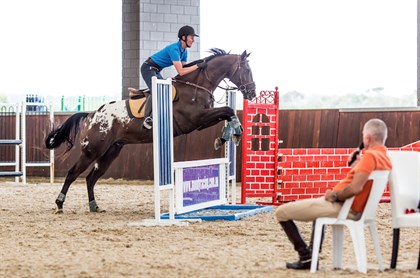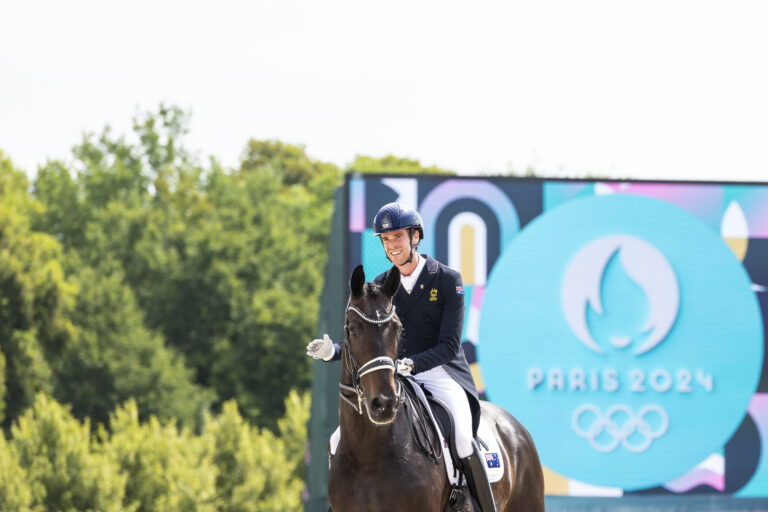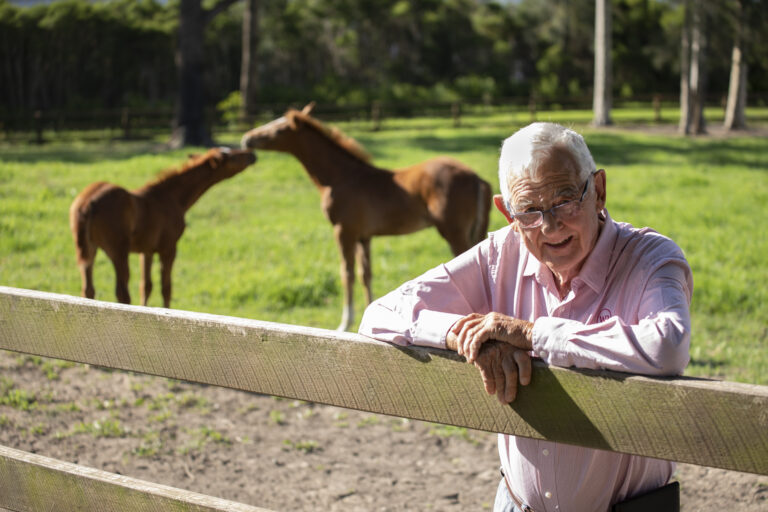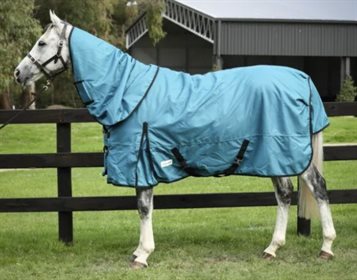This article has appeared previously with Equestrian Life. To see what’s in our latest issue, click here.
Jane Riley and Sirspotalot jump, as George watches on.
By Dr Kerry Mack
Photography by Katherine Jamison
“UNRELENTING” is the title of the autobiography of George Morris, possibly the most famous showjumping coach in the world. George is unrelenting, as we learn at his Australian showjumping clinic.
George Morris’ career in showjumping spans six decades, first as a rider and then as a successful coach. Most recently, he coached the Brazilian team for the 2016 Olympic Games in Rio. Connecticut-born, George came through the training system of Bert de Nemethy who was trained in classical horsemanship — initially in the Hungarian Cavalry and then in Germany. George was a very successful competitor, riding on eight winning Nations Cup teams up to 1960 when he was also a team silver medallist at the Rome Olympics. He has been a fairly regular contributor to Australian jumping since the late 1980s. In fact, I did several clinics with him a lifetime ago when I was a jumping rider. Many of our top riders have trained under him, notably Vicki Roycroft.
Jane Riley and Sirspotalot.
Thanks to Vicki, once again we had the privilege of seeing him in Australia this January. In Melbourne this was another premium event hosted by the wonderful Boneo Park. At the ripe age of 79, George Morris is still a master horseman. He chose the most sensitive and difficult horses to ride and showed us how to tactfully ride them through to become more stable in the contact.
George is fastidious about the details. He says “training is meticulous and slow”. He is very concerned about position. Each lesson starts with a detailed explanation about what he wants in position and why. “Heels are the anchor… Eyes up, heels down,” he commands. “If your eyes are up it gives you better balance, your aids will work better. Your heels down will give you security. It also gives you the driving aids.”
“This is a jumping clinic. Your body must always be in advance of the base of support. The body is 30 degrees in front of the vertical for rising trot, galloping and for jumping. At the walk the body is five degrees in front of the vertical. You must sit over the strong part of his back, just behind the wither. Relax the knee, don’t pinch the knee…”
Every hand action is intermittent, give and take. You ride with your legs and regulate with the hands. “Hands resist, they don’t pull,’’ says George. “Grip the rein with your thumb, that’s how you resist the horse. Keep your hands up when he resists you. Close your fingers on the rein and carry your hands. Use your hands like you are squeezing a lemon. You have to acquire perfectly stable hands so you can ride legs against hand.”
Aaron Mawhinney and Snowy River Lindberg.
There are three ways to use your hands. According to the French, the first rein aid is the opening rein (the hand goes towards the inside of the horse, not pulling back). The direct rein turns the horse; the hand does pull back on the corners of the mouth. The right rein affects the right hindleg. We use the direct rein for slowing, backing, stopping and turning.
The third way to use the hand is the indirect rein, like a neck rein. The outside hand pulls a little back and across the neck. The rein pushes the horse in the opposite direction. The right rein moves the shoulder to the left.
“Your horse must accept the hand. If he resists, keep the hand up. Don’t put it down on the wither. If he resists, close your fingers on the rein. Carry your hands. You push the head down with your legs. Inside leg to outside hand.”
Stirrups for flatwork are two holes longer than jumping length. The flatwork is very similar to the work we saw Carl Hester teach at his recent Masterclass in Melbourne. George wants the horse to be ridden from the back to the front. “The principles of the sport are ancient; the horse is ridden from behind,” he says.
Ingrid Williamson and Tulara Conika.
The rider’s hands stay relatively high. There is a straight line from the horse’s mouth to the elbow. Hands do not pull the head down. He keeps telling riders to lift their hands up. I don’t think he really wants them high; he just doesn’t want the hands down low, pulling.
Trot work is all in rising trot, forward position. A few transitions to start. Trot, halt, trot. Canter, walk, canter. Lateral work is a big focus and gets more complicated over the three days. “The dressage exercises build the mind and body of the horse progressively,” explains George.
On the first day he starts with shoulder-fore at walk. Bend is not required initially. The shoulders of the horse come onto an inside track. The hindquarter stays on the outside track. When the horses can do this easily, there are variations. George gets on and demonstrates a serpentine across the width of the arena. Three 10-metre half-circles. The rhythm stays the same but the hindquarters are pushed to the outside in the half-circles. Half-circle left with the quarters pushed out to the right, straight, change diagonal, change the outside rein and the bend, right half-circle, hindquarters pushed to the left. In canter, the rider’s inside leg pushes the horse’s inside hindleg into the track of the outside front leg. This is shoulder-fore position again.
Caitlin Healy and Laboulaye.
Later in the clinic he wants bending. The shoulder-fore becomes shoulder-in. Then he wants the quarters in, first without bend, then with inside bend. He calls this “counter shoulder-in”. “The priority is the haunches in, the bend is after.” I would call this travers. This requires a high degree of suppleness and obedience of the horse. This will help you have control of the outside of the horse, and will help you turn him, so he doesn’t drift through the outside of the turn.
George explains that he doesn’t like the term “leg-yield”. “I want flexion,” he says, “to mobilise the haunches, to mobilise the shoulder, not just yield from the leg.” I can see his point and I like the emphasis he places on the suppleness of the horse, not just the reaction to the leg. You must teach the horse to yield sideways from the leg in order to be able to progress to the shoulder-fore, shoulder-in etc. Shoulder-in is well established as one of the key exercises to develop collection. The shoulder-in puts the inside hindleg under the body of the horse to help develop the capacity to carry weight on the hindleg. This is an important goal of training the horse.
He recommends: “Counter canter is important. You people should live in counter canter. You should have perfect counter canter.” He wants bend; left bend in the left counter canter. “Counter canter helps to collect the canter.”
The clinic was held at Boneo Park.
George Morris brings a very consistent, classically informed message. Ride from the back to the front. Push down with the leg, don’t pull them down. “You people have to be soft,” he says.
“Circles and shoulder-in are the basis of equitation. There is nothing new. My whole life is inside leg to outside rein,” he emphasises loudly.
With regard to the Training Scale, George disagrees with the order of its elements. The German training scale is Rhythm, Suppleness, Contact, Impulsion, Straightness and Collection. George argues that you can’t have rhythm unless you have impulsion first; you can’t have suppleness until you have contact. So his training scale is Impulsion, Straightness, Rhythm, Contact, Suppleness and Collection. “It’s like driving a car – you turn it on – that’s impulsion, it’s first.”
Stirrups are shortened two holes before jumping. “The stirrups must be short enough so the heels can stay down.” The jumping starts with a simple trot and pop, but the emphasis is on the rider’s position. He does not want riders to be sitting in the saddle. Two-point position is required at all times when jumping. The rider is balanced over two feet. “Get out of the saddle” is a frequent instruction.
The jumping exercises progress over the course of the clinic. The emphasis is on control. “You have to teach him to jump out of the trot.” After some simple gymnastics, the real jumping begins. Each day there are different related distances where the riders determine the number of strides between the fences by bending the lines, and choosing where on the fence to ride – left inside line for three strides, right outside line for four strides. The canter changes a bit, but it’s the precision of the rider that mainly determines the strides. For example, left rein to an oxer, three strides to planks, slight right turn and four strides to a triple bar. Each time George wants the short, balanced option — e.g. four strides — before he wants the forward, longer striding option — e.g. three strides.
The “training” and flatwork is integrated into the jumping. A line is jumped and the horse is put on a circle, shoulder-in, quarters in. The horse must stay supple and responsive to the aids after a jump. The horse must accept the inside leg after the fence. The horse must wait. George is happy to use the wall to stop the horse. He gets the rider to ride deep into the corners of the arena and stop toward the wall. I am reminded of Tom Dorrance’s tenet of “make the right thing easy”. It’s easy to get him to choose to stop if you steer him towards the wall. Wait, stand six seconds. “This is discipline,” says George.
George Morris.
© Jenelle Christopher
If you want to read more of the specific exercises George worked on, they will be included as part of my blog on the EQ Life website.
“Unrelenting” sums up George Morris. His theory, his explanations and the exercises, I think, are exceptional. However, some are critical of how he treats people. He is well known for having poor manners. Some people watching in the gallery found his verbal antics amusing — I didn’t. Intimidation, bullying and verbal abuse are not okay; it makes the perpetrator look bad. It does not help people learn and is never appropriate if a coach’s goal is to help people. It is a great shame to see this conduct, as a truly great coach who is genuinely interested in helping people improve would bring out the best in people by empowering them, not intimidating them.
READ THE LATEST NEWS ARTICLES HERE








